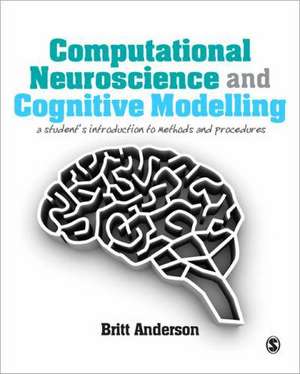Computational Neuroscience and Cognitive Modelling: A Student's Introduction to Methods and Procedures
Autor Britt Andersonen Limba Engleză Paperback – 13 ian 2014
- Anjan Chatterjee, Professor of Neurology, University of Pennsylvania
"Anderson provides a gentle introduction to computational aspects of psychological science, managing to respect the reader’s intelligence while also being completely unintimidating. Using carefully-selected computational demonstrations, he guides students through a wide array of important approaches and tools, with little in the way of prerequisites...I recommend it with enthusiasm."
- Asohan Amarasingham, The City University of New York
This unique, self-contained and accessible textbook provides an introduction to computational modelling neuroscience accessible to readers with little or no background in computing or mathematics. Organized into thematic sections, the book spans from modelling integrate and firing neurons to playing the game Rock, Paper, Scissors in ACT-R. This non-technical guide shows how basic knowledge and modern computers can be combined for interesting simulations, progressing from early exercises utilizing spreadsheets, to simple programs in Python. Key Features include:
- Interleaved chapters that show how traditional computing constructs are simply disguised versions of the spread sheet methods.
- Mathematical facts and notation needed to understand the modelling methods are presented at their most basic and are interleaved with biographical and historical notes for contex.
- Numerous worked examples to demonstrate the themes and procedures of cognitive modelling.
| Toate formatele și edițiile | Preț | Express |
|---|---|---|
| Paperback (1) | 397.06 lei 3-5 săpt. | +19.24 lei 6-12 zile |
| SAGE Publications – 13 ian 2014 | 397.06 lei 3-5 săpt. | +19.24 lei 6-12 zile |
| Hardback (1) | 1057.75 lei 6-8 săpt. | |
| SAGE Publications – 13 ian 2014 | 1057.75 lei 6-8 săpt. |
Preț: 397.06 lei
Preț vechi: 431.58 lei
-8% Nou
Puncte Express: 596
Preț estimativ în valută:
75.98€ • 79.49$ • 63.11£
75.98€ • 79.49$ • 63.11£
Carte disponibilă
Livrare economică 13-27 martie
Livrare express 26 februarie-04 martie pentru 29.23 lei
Preluare comenzi: 021 569.72.76
Specificații
ISBN-13: 9781446249307
ISBN-10: 1446249301
Pagini: 240
Dimensiuni: 170 x 242 x 13 mm
Greutate: 0.41 kg
Ediția:New.
Editura: SAGE Publications
Colecția Sage Publications Ltd
Locul publicării:London, United Kingdom
ISBN-10: 1446249301
Pagini: 240
Dimensiuni: 170 x 242 x 13 mm
Greutate: 0.41 kg
Ediția:New.
Editura: SAGE Publications
Colecția Sage Publications Ltd
Locul publicării:London, United Kingdom
Recenzii
For the neuroscientist or psychologist who cringes at the sight of mathematical formulae and whose eyes glaze over at terms like differential equations, linear algebra, vectors, matrices, Bayes’ rule, and Boolean logic, this book just might be the therapy needed. Britt Anderson guides the reader into the world of computational methods; writing lucidly and grounding this journey with elegantly constructed exercises. His slender book is an invitation to use tools that will help students and scientists think about neural and psychological mechanisms with rigor and precision.
The neural and cognitive sciences are increasingly quantitative and computational subjects, and curriculums are now attempting to reflect this emerging reality. Accordingly, an important educational challenge is to inform undergraduate students of the significance of computational thinking, while also preparing them to appreciate and criticize it. An Invitation to Computational Neuroscience and Cognitive Modeling achieves this difficult goal wonderfully. Anderson provides a gentle introduction to computational aspects of psychological science, managing to respect the reader’s intelligence while also being completely unintimidating. Using carefully-selected computational demonstrations, he guides students through a wide array of important approaches and tools, with little in the way of prerequisites. As well as a very practical introduction to computer programming, there is impressive coverage of dynamical systems models of neurons, neural network models of memory, probabilistic models of decision-making, and mathematical models of thought. I recommend it with enthusiasm.
The neural and cognitive sciences are increasingly quantitative and computational subjects, and curriculums are now attempting to reflect this emerging reality. Accordingly, an important educational challenge is to inform undergraduate students of the significance of computational thinking, while also preparing them to appreciate and criticize it. An Invitation to Computational Neuroscience and Cognitive Modeling achieves this difficult goal wonderfully. Anderson provides a gentle introduction to computational aspects of psychological science, managing to respect the reader’s intelligence while also being completely unintimidating. Using carefully-selected computational demonstrations, he guides students through a wide array of important approaches and tools, with little in the way of prerequisites. As well as a very practical introduction to computer programming, there is impressive coverage of dynamical systems models of neurons, neural network models of memory, probabilistic models of decision-making, and mathematical models of thought. I recommend it with enthusiasm.
Cuprins
Chapter 1: Introduction
PART 1: Modeling Neurons
Chapter 2: What is a Differential Equation?
Chapter 3: Numerical Application of a Differential Equation
Chapter 4: Intermezzo: Computing With Loops
Chapter 5: Integrate & Fire
Chapter 6: Intermezzo: Computing With If Statements
Chapter 7: Hodgkin & Huxley: The Men and Their Model
Chapter 8: Intermezzo: Computing With Functions
PART 2: Neural Networks
Chapter 9: Neural Network Mathematics: Vectors and Matrices
Chapter 10: Intermezzo: Interactive Computing
Chapter 11: An Introduction to Neural Networks
Chapter 12: Intermezzo: Interactive Exploration of the Delta Rule with Octave
Chapter 13: Auto-associative Memory and the Hopfield Net
PART 3: Probability and Psychological Models
Chapter 14: What are the Odds?
Chapter 15: Decisions as Random Walks
Chapter 16: Intermezzo: Programming Psychophysical Experiments with Python
PART 4: Cognitive Modeling as Logic and Rules
Chapter 17: Boolean Logic
Chapter 18: Intermezzo: Computing With Functional Languages
Chapter 19: Production Rules and Cognition
Chapter 20: Intermezzo: Functional Coding of a Simple Production System
Chapter 21 ACT-R: A Cognitive Architecture
Chapter 22: Agent Based Modeling
Chapter 23: Concluding Remarks
PART 1: Modeling Neurons
Chapter 2: What is a Differential Equation?
Chapter 3: Numerical Application of a Differential Equation
Chapter 4: Intermezzo: Computing With Loops
Chapter 5: Integrate & Fire
Chapter 6: Intermezzo: Computing With If Statements
Chapter 7: Hodgkin & Huxley: The Men and Their Model
Chapter 8: Intermezzo: Computing With Functions
PART 2: Neural Networks
Chapter 9: Neural Network Mathematics: Vectors and Matrices
Chapter 10: Intermezzo: Interactive Computing
Chapter 11: An Introduction to Neural Networks
Chapter 12: Intermezzo: Interactive Exploration of the Delta Rule with Octave
Chapter 13: Auto-associative Memory and the Hopfield Net
PART 3: Probability and Psychological Models
Chapter 14: What are the Odds?
Chapter 15: Decisions as Random Walks
Chapter 16: Intermezzo: Programming Psychophysical Experiments with Python
PART 4: Cognitive Modeling as Logic and Rules
Chapter 17: Boolean Logic
Chapter 18: Intermezzo: Computing With Functional Languages
Chapter 19: Production Rules and Cognition
Chapter 20: Intermezzo: Functional Coding of a Simple Production System
Chapter 21 ACT-R: A Cognitive Architecture
Chapter 22: Agent Based Modeling
Chapter 23: Concluding Remarks
Notă biografică
Britt Anderson graduated from the University of Southern California School of Medicine and trained in Neurology at the University of Texas Southwestern Medical Center at Dallas. Subsequently, he received a PhD in Brain Science from Brown University. Since 2007 he has been a faculty member in the Dept of Psychology and a member of the Centre for Theoretical Neuroscience at the University of Waterloo, Canada.
Descriere
This unique, self-contained and accessible textbook provides an introduction to computational modelling in psychology and neuroscience accessible to students with little or no background in computing or mathematics.














